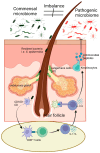Microbiome and Postbiotics in Skin Health
- PMID: 40299368
- PMCID: PMC12025169
- DOI: 10.3390/biomedicines13040791
Microbiome and Postbiotics in Skin Health
Abstract
The skin microbiome, a diverse and dynamic ecosystem of microorganisms, plays a pivotal role in maintaining skin health by interacting with skin cells, immune components, and structural barriers. It is essential for skin homeostasis, immune defense, and protection against pathogenic colonization. Dysbiosis in the microbiome has been implicated in numerous dermatological conditions, including acne, eczema, psoriasis, and rosacea. Acne, the most prevalent skin condition, affects up to 85% of individuals at some point in their lives, while eczema and psoriasis impose significant public health and economic burdens. The composition of the skin microbiome varies across skin types and anatomical sites, with sebaceous, moist, and dry areas fostering distinct microbial communities. Emerging therapeutic strategies such as microbiome-targeted treatments offer novel avenues for addressing skin diseases. Among these approaches, postbiotics have gained significant attention for their safety and efficacy. Unlike probiotics, postbiotics are non-viable microbial cells or their metabolites, which reduce safety concerns while providing functional benefits such as UV protection and wound healing. This review consolidates current insights into the role of the skin microbiome in health and disease, emphasizing postbiotics as a promising therapeutic strategy by exploring the clinical and commercial potential of microbiome-based treatments, particularly postbiotics, and their ability to redefine dermatological care and improve patient outcomes.
Keywords: acne; dermatology; eczema; postbiotics; psoriasis; skin barrier function; skin diseases; skin health; skin microbiome.
Conflict of interest statement
Hariom Yadav is cofounder and chief scientific officer of Postbiotics Inc. and BiomAge Inc. He is also cofounder of MusB LLC, MusB Research LLC and MeraBiome Inc. with Shalini Jain. However, they have no conflicts of interest with respect to the work/literature review presented in this manuscript.
Figures

 ) indicates inhibitory pathway.
) indicates inhibitory pathway.

References
-
- Alves A.C., Martins S.M.d.S.B., Jr., Belo J.V.T., Lemos M.V.C., Lima C.E.d.M.C., Silva C.D.d., Zagmignan A., Nascimento da Silva L.C. Global Trends and Scientific Impact of Topical Probiotics in Dermatological Treatment and Skincare. Microorganisms. 2024;12:2010. doi: 10.3390/microorganisms12102010. - DOI - PMC - PubMed
-
- Prescott S.L., Larcombe D.-L., Logan A.C., West C., Burks W., Caraballo L., Levin M., Etten E.V., Horwitz P., Kozyrskyj A. The skin microbiome: Impact of modern environments on skin ecology, barrier integrity, and systemic immune programming. World Allergy Organ. J. 2017;10:29. doi: 10.1186/s40413-017-0160-5. - DOI - PMC - PubMed
Publication types
Grants and funding
LinkOut - more resources
Full Text Sources

